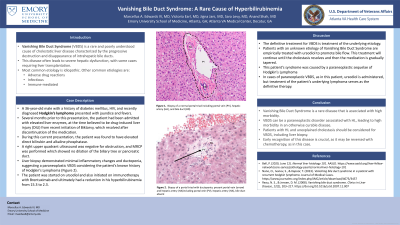Monday Poster Session
Category: Liver
P2569 - Vanishing Bile Duct Syndrome: A Rare Cause of Hyperbilirubinemia
Monday, October 23, 2023
10:30 AM - 4:15 PM PT
Location: Exhibit Hall

Has Audio

Marcellus A. Edwards, IV, MD
Emory University School of Medicine
Atlanta, GA
Presenting Author(s)
Marcellus A. Edwards, MD1, Victoria Earl, MD1, Jigna Jani, MD2, Sara Levy, MD1, Anand Shah, MD3
1Emory University School of Medicine, Atlanta, GA; 2Atlanta VA Medical Center, Decatur, GA; 3Emory University School of Medicine, Decatur, GA
Introduction: Vanishing Bile Duct Syndrome (VBDS) is a rare and poorly understood form of cholestatic liver disease characterized by the progressive destruction and loss of intrahepatic bile ducts. This case report describes a young male with Hodgkin’s Lymphoma who presented to our hospital with elevated bilirubin and was ultimately diagnosed with paraneoplastic VBDS.
Case Description/Methods: A 36-year-old male with a history of DM, HIV, and recently diagnosed HL presented with jaundice and fevers. Several months prior to this presentation, he had been admitted with elevated liver enzymes, believed to be drug-induced liver injury (DILI) from recent initiation of Biktarvy, which resolved after discontinuation. During this current presentation, the patient was found to have elevated direct bilirubin and alkaline phosphatase. A right upper quadrant ultrasound was negative for obstruction, and MRCP was performed which showed no dilation of the biliary tree or pancreatic duct. Liver biopsy demonstrated minimal inflammatory changes and ductopenia, suggesting a paraneoplastic VBDS considering the patient’s known history of Hodgkin’s Lymphoma. The patient was initiated on immunotherapy with Brentuximab. Over the course of treatment, a significant reduction in his hyperbilirubinemia, from 15.3 to 2.3, and clinical remission from HL were achieved.
Discussion: VBDS has a variety of etiologies including adverse drug reactions, infectious, immune-mediated that can ultimately lead to cirrhosis or liver failure and often require liver transplant to treat. VBDS has also been described as a rare paraneoplastic disorder associated with HL, leading to high morbidity in an otherwise curable disease. Our report suggests that patients with HL and unexplained cholestasis should be considered for VBDS work up, including liver biopsy. Early recognition of this disease is crucial, as it may be reversed with chemotherapy, as in this case.
Disclosures:
Marcellus A. Edwards, MD1, Victoria Earl, MD1, Jigna Jani, MD2, Sara Levy, MD1, Anand Shah, MD3. P2569 - Vanishing Bile Duct Syndrome: A Rare Cause of Hyperbilirubinemia, ACG 2023 Annual Scientific Meeting Abstracts. Vancouver, BC, Canada: American College of Gastroenterology.
1Emory University School of Medicine, Atlanta, GA; 2Atlanta VA Medical Center, Decatur, GA; 3Emory University School of Medicine, Decatur, GA
Introduction: Vanishing Bile Duct Syndrome (VBDS) is a rare and poorly understood form of cholestatic liver disease characterized by the progressive destruction and loss of intrahepatic bile ducts. This case report describes a young male with Hodgkin’s Lymphoma who presented to our hospital with elevated bilirubin and was ultimately diagnosed with paraneoplastic VBDS.
Case Description/Methods: A 36-year-old male with a history of DM, HIV, and recently diagnosed HL presented with jaundice and fevers. Several months prior to this presentation, he had been admitted with elevated liver enzymes, believed to be drug-induced liver injury (DILI) from recent initiation of Biktarvy, which resolved after discontinuation. During this current presentation, the patient was found to have elevated direct bilirubin and alkaline phosphatase. A right upper quadrant ultrasound was negative for obstruction, and MRCP was performed which showed no dilation of the biliary tree or pancreatic duct. Liver biopsy demonstrated minimal inflammatory changes and ductopenia, suggesting a paraneoplastic VBDS considering the patient’s known history of Hodgkin’s Lymphoma. The patient was initiated on immunotherapy with Brentuximab. Over the course of treatment, a significant reduction in his hyperbilirubinemia, from 15.3 to 2.3, and clinical remission from HL were achieved.
Discussion: VBDS has a variety of etiologies including adverse drug reactions, infectious, immune-mediated that can ultimately lead to cirrhosis or liver failure and often require liver transplant to treat. VBDS has also been described as a rare paraneoplastic disorder associated with HL, leading to high morbidity in an otherwise curable disease. Our report suggests that patients with HL and unexplained cholestasis should be considered for VBDS work up, including liver biopsy. Early recognition of this disease is crucial, as it may be reversed with chemotherapy, as in this case.
Disclosures:
Marcellus Edwards indicated no relevant financial relationships.
Victoria Earl indicated no relevant financial relationships.
Jigna Jani indicated no relevant financial relationships.
Sara Levy indicated no relevant financial relationships.
Anand Shah indicated no relevant financial relationships.
Marcellus A. Edwards, MD1, Victoria Earl, MD1, Jigna Jani, MD2, Sara Levy, MD1, Anand Shah, MD3. P2569 - Vanishing Bile Duct Syndrome: A Rare Cause of Hyperbilirubinemia, ACG 2023 Annual Scientific Meeting Abstracts. Vancouver, BC, Canada: American College of Gastroenterology.
